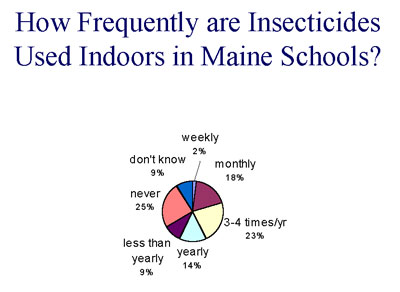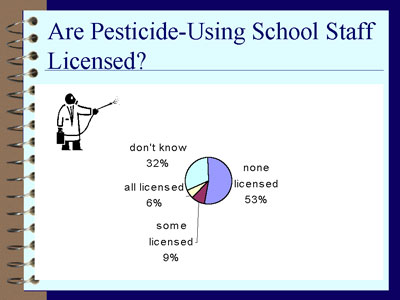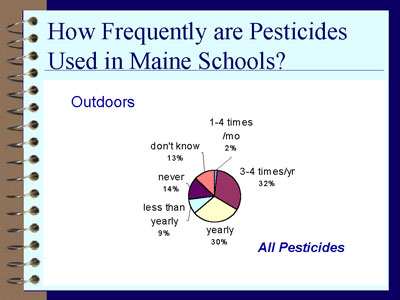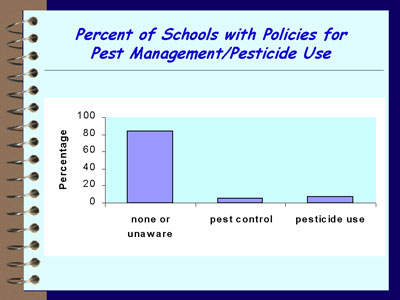 |
 |
 |
 |
… and Lack of IPM and Applicator Training
If you suspected that your kids were being exposed to pesticides in their schools, your hunch was probably right. A survey of Maine schools earlier this year showed widespread pesticide use, without notice to parents and kids, often without application by a licensed professional (a violation of the law) and hardly ever with an integrated pest management plan. Kathy Murray, Ph.D., an entomologist who was hired last year as the Department of Agriculture’s IPM specialist, undertook the survey after MOFGA suggested that pesticides in schools would be a good area of focus. As Murray noted in her report to the Board of Pesticides Control on November 4, children are developmentally and neurologically particularly susceptible to pesticides, and engage in behaviors at school, such as crawling on the floor or rolling on turf, that expose them more than adults. Murray, who has school age children of her own, also spoke on this issue at the Public Policy Teach-in on pesticides in schools at the 1999 Common Ground Fair. Before Murray undertook her project, little if anything was known about whether schools apply pesticides, how often they’re applied, and by whom.
The results of the survey are disturbing, and certainly make an excellent case for the further work Murray is engaged in to educate school professionals in proper approaches to pesticide use. Murray’s aggressive follow-up efforts after mailing the survey led to an exceptionally high response rate. Questionnaires were mailed to 336 individuals identified by their school district superintendents as responsible for pest management in the schools. Seventy-eight percent of the questionnaires were completed and returned, representing 88% of the 168 Maine school districts.
Indoors, 57% of respondents indicated that insecticides were used at least once a year; 42% responded that they were applied three or more times a year, and 2% applied them weekly. (These questions excluded disinfectants, which were addressed by separate questions.) Twenty-five percent of respondents, however, indicated that insecticides were never used.
Outdoors, 34% of respondents indicated that pesticides were applied three or more times a year. Fourteen percent never applied outdoors.
Sixty-two percent of schools reported that pesticide applications were made by school staff rather than contractors. When these respondents were asked whether school staff applying pesticides were licensed (the law requires all applicators in public, commercial and residential dwellings to be trained and licensed, unless you are applying in your own home), 53% responded that they weren’t licensed, and 32% responded that they “didn’t know.” When asked whether their schools had a policy for integrated pest management (IPM – defined as “a systematic approach to keeping pests below harmful levels which uses a variety of methods for monitoring and managing pests and often minimizes pesticide use”), 82% responded “no” or that they were unaware of any.
Only 5% of schools provide written notice of when pesticides are to be applied, and only 2% maintain a list of chemically sensitive occupants.
Murray is now spearheading a cooperative effort of the Board of Pesticides Control and Cooperative Extension to educate school personnel about pesticide use.
In addition to the EPA grant that funded the survey, she has secured $53,000 in EPA funds to pursue this educational effort. Seventy-two of the 168 school districts have signed up for a three-hour on-site training session with a professional in turf Integrated Pest Management. Cooperative Extension is writing an outdoor IPM manual for schools, and Murray is hiring an indoor IPM training program director. Faced with the revelation that their custodial staffs have to be trained and licensed by the BPC, Murray said many schools may turn to outside commercial contractors for their pesticide applications. This, however, is not necessarily a solution. Murray recounted her review of the log of a commercial applicator in a school, who reported monthly visits finding “no pests observed,” and applied pesticides nonetheless. Schools have to be vigilant in demanding IPM from their contractors, and should know enough to be sure they’re really getting it.
